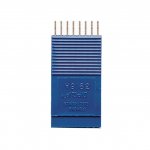While at this point Tezza's keyboard appears fine, this does raise the possibility of easily verifying the keyboard, now or some time in the future.
MikeS: I direct this to you, because I know you've connected more things to the Tandy Model 100's RS-232 than I can shake a stick at! Should the following work?: Leave the keyboard connected to the Kaypro, so the keyboard retains its power supply (assumed to be 5V). Connect Pin 2 of the Kaypro's keyboard socket (output signal from keyboard) and connect to Pin 3 (RxD) of the M100. Plus connect grounds. Enter TELCOM on M100 & adjust settings. With a bit of luck, keys depressed should appear on M100.
Philip

